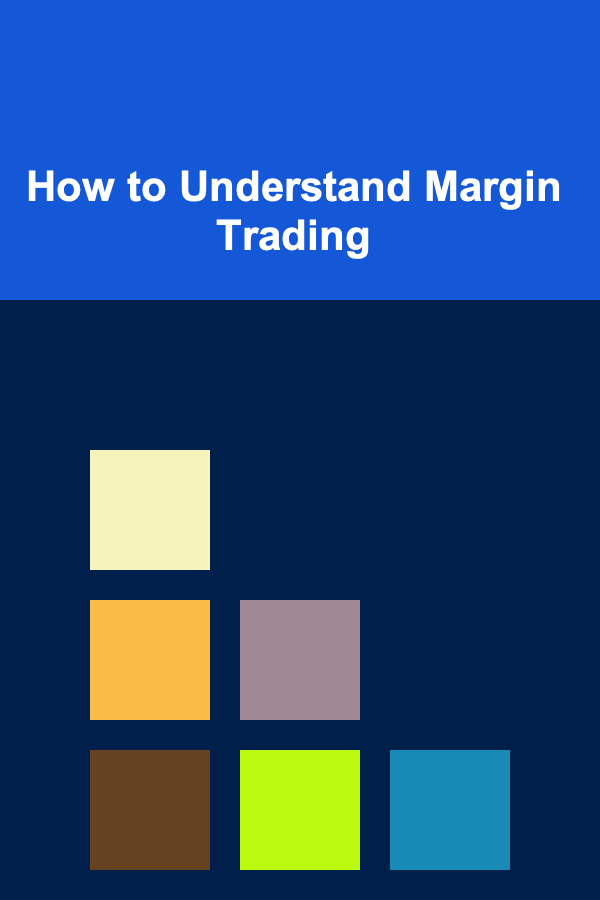
How to Understand Margin Trading
ebook include PDF & Audio bundle (Micro Guide)
$12.99$6.99
Limited Time Offer! Order within the next:

Margin trading is a concept that has gained significant traction in recent years, especially with the rise of retail investors participating in stock markets and other financial markets. While margin trading can potentially amplify profits, it also comes with high risk and complexity that investors must carefully understand before diving in. This article will provide an in-depth exploration of margin trading, explaining its mechanics, risks, benefits, and strategies.
What is Margin Trading?
Margin trading refers to the practice of borrowing funds from a broker or financial institution to trade financial assets, such as stocks, currencies, commodities, or cryptocurrencies. In other words, margin trading allows an investor to use borrowed money (leverage) to increase the size of their trading positions, potentially leading to higher returns. However, with the opportunity for greater profit comes the risk of more significant losses.
When you engage in margin trading, you're essentially using your existing investments or cash as collateral to borrow money. The borrowed funds are typically provided by a broker who charges interest on the loan, and you are required to maintain a certain level of equity (your margin) in your account to ensure that the loan is repaid.
Example of Margin Trading
Imagine you have $10,000 in your trading account. If the margin requirement is 50%, this means you can borrow an additional $10,000 from your broker, giving you a total of $20,000 to trade. If the investment increases in value, your profit will be based on the $20,000 position, even though you only put up $10,000 of your own money. Conversely, if the investment decreases in value, you stand to lose more than if you had only used your own capital.
How Margin Trading Works
To understand margin trading, it's essential to grasp the concept of margin itself. The margin is the amount of money that an investor needs to put up as collateral when borrowing funds to trade. This margin is expressed as a percentage of the total trade value and is typically set by the broker.
Key Components of Margin Trading
- Initial Margin: The initial margin is the amount of money you need to deposit into your account to open a margin trade. This is usually a percentage of the total value of the trade and is set by the broker. For example, if you are buying $10,000 worth of stock and the initial margin requirement is 50%, you would need to deposit $5,000 of your own money, while the broker lends you the remaining $5,000.
- Maintenance Margin: The maintenance margin is the minimum equity level that must be maintained in the margin account to avoid a margin call. This level is typically lower than the initial margin and represents the minimum amount of collateral you need to hold to keep the trade open. If your account equity falls below the maintenance margin, you may receive a margin call from the broker, requiring you to deposit additional funds to bring your equity back to the required level.
- Margin Call: A margin call occurs when the value of your investments falls below the maintenance margin level. In this case, the broker will request that you deposit more money or liquidate assets to bring the margin back up. If you fail to meet the margin call, the broker has the right to sell your assets to cover the loan.
- Leverage: Leverage refers to the ability to control a large position with a smaller amount of capital. In margin trading, leverage is typically expressed as a ratio, such as 2:1 or 5:1. For example, a 2:1 leverage ratio means that for every $1 of your own capital, you can borrow an additional $1 to control $2 worth of assets. While leverage amplifies both potential gains and losses, it allows traders to access larger positions without needing to invest a larger amount of money upfront.
Example of How Margin Trading Works
Let's break down an example to illustrate how margin trading works in practice. Suppose you want to buy 100 shares of a stock that costs $100 per share, and your broker requires a 50% margin. The total value of the trade would be $10,000 (100 shares * $100 per share). With a 50% margin requirement, you would need to deposit $5,000, and the broker would lend you the remaining $5,000.
- If the stock price rises to $120 per share, your 100 shares would be worth $12,000. You can then sell the shares, repay the $5,000 loan, and keep the $2,000 profit (before any fees or interest charges).
- If the stock price falls to $80 per share, your 100 shares would be worth only $8,000. After repaying the $5,000 loan, you would be left with just $3,000, resulting in a loss of $2,000.
In this example, the potential for profit is greater with margin trading, but so is the potential for loss.
Types of Margin Accounts
There are two main types of margin accounts used in trading:
1. Cash Account
A cash account is a basic type of account where you can only trade with the funds you have deposited. In other words, you cannot borrow money to make trades. While this type of account does not involve margin trading, it is often used as a starting point for traders who are learning the basics of trading.
2. Margin Account
A margin account allows you to borrow money from your broker to trade. This type of account is required for margin trading and comes with the ability to use leverage to amplify your trades. It also requires maintaining a minimum balance to keep the margin trade open.
Risks of Margin Trading
While margin trading offers the potential for higher returns, it also introduces significant risks that traders must be aware of. Understanding these risks is critical to managing the potential for loss.
1. Amplified Losses
The most significant risk of margin trading is the potential for amplified losses. Since margin trading allows you to borrow funds to increase your position size, any losses are also magnified. If the market moves against you, you can lose more than your initial investment. In extreme cases, you may be required to deposit more funds to cover your losses, or the broker may liquidate your position to protect themselves.
2. Margin Calls
A margin call occurs when your account equity falls below the maintenance margin requirement. When this happens, the broker will demand that you deposit more funds into your account or liquidate assets to cover the shortfall. If you are unable to meet the margin call, the broker may sell off your investments to recover the borrowed funds, often at a loss.
3. Interest Costs
Margin trading comes with interest costs, which can add up over time. The broker typically charges interest on the borrowed funds, and the rate can vary depending on the size of the loan and the broker's terms. These interest charges can eat into any potential profits and may lead to significant costs if positions are held for an extended period.
4. Risk of Overleveraging
One of the most common mistakes in margin trading is overleveraging, where traders take on more risk than they can manage. When using high leverage, even a small market movement can lead to large gains or losses. Overleveraging can cause traders to lose more money than they initially invested and may result in a margin call.
Benefits of Margin Trading
Despite the risks, margin trading offers several benefits that make it attractive to experienced traders and investors.
1. Increased Buying Power
The primary benefit of margin trading is the increased buying power it provides. With margin, you can control a larger position than you would be able to with just your own capital. This allows for more significant potential returns on successful trades.
2. Diversification
Margin trading allows you to diversify your portfolio by giving you the ability to take multiple positions simultaneously. With margin, you can spread your capital across different assets or markets, which can help mitigate risk.
3. Short Selling
Margin accounts are often used to facilitate short selling, a strategy in which traders borrow shares to sell them at current market prices, hoping to buy them back at a lower price. Short selling can be a powerful tool for profiting in falling markets, and margin trading provides the necessary leverage to execute such trades.
4. Flexibility and Leverage in Trading Strategies
Margin trading allows traders to employ more sophisticated trading strategies, such as using options, futures, or other derivative products. By using margin, traders can enhance their strategies and increase their potential returns.
Conclusion
Margin trading is a powerful tool that can offer significant rewards but also comes with substantial risks. It requires a solid understanding of the mechanics, the risks involved, and the ability to manage leverage effectively. While margin trading can amplify potential profits, it also magnifies losses, so it's crucial to exercise caution and develop a strategy that accounts for both the rewards and the risks.
For those new to margin trading, it's important to start with a small amount of capital and work with a broker that provides clear guidelines and educational resources. Always ensure that you understand the terms and conditions of margin trading before engaging in it, and consider consulting a financial advisor to help you navigate the complexities of leveraged trading.
In the end, margin trading is not suitable for everyone. It requires discipline, risk management, and a deep understanding of market dynamics. However, for those who approach it with caution and knowledge, margin trading can be an effective way to enhance their trading strategies and achieve higher returns.
Reading More From Our Other Websites
- [Personal Care Tips 101] How to Eat to Reduce Insulin Resistance Naturally
- [Home Cleaning 101] How to Deep Clean Your Mattress for Better Sleep
- [Home Family Activity 101] How to Keep Kids Entertained with Craft Projects at Home
- [Home Rental Property 101] How to Determine if Houses for Rent with a Built-In Sound System Are Worth the Extra Cost
- [Survival Kit 101] Best Bug‑Out Bag Survival Kit for Preppers: Building Your Emergency Plan
- [Home Maintenance 101] How to Optimize Your Oven for Baking and Roasting
- [Polymer Clay Modeling Tip 101] Best Polymer Clay Botanical Sculptures: Mastering Texture & Detail
- [Home Budget Decorating 101] How to Create a Gallery Wall for Under $50
- [Home Family Activity 101] How to Make Homemade Ice Cream with the Whole Family
- [Simple Life Tip 101] Best Low‑Cost Ways to Celebrate Milestones Without Excess

How to Evaluate Dog Boarding Facilities Like Hyde Park
Read More
How to Organize Your Equipment for Team Practices
Read More
How to Plan a Successful Outdoor Party in Your Backyard
Read More
Finding Solitude in the Forests of Canada
Read More
How to Research Political Trends Effectively
Read More
10 Tips for Luxury Product Packaging Design
Read MoreOther Products

How to Evaluate Dog Boarding Facilities Like Hyde Park
Read More
How to Organize Your Equipment for Team Practices
Read More
How to Plan a Successful Outdoor Party in Your Backyard
Read More
Finding Solitude in the Forests of Canada
Read More
How to Research Political Trends Effectively
Read More